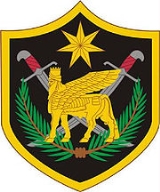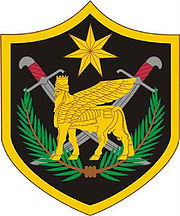
Multi-National Security Transition Command - Iraq
Encyclopedia

Multinational force in Iraq
The Multi-National Force – Iraq was a military command, led by the United States, which was responsible for Operation Iraqi Freedom. Multi-National Force – Iraq replaced the previous force, Combined Joint Task Force 7, on 15 May 2004, and was later itself reorganized into its successor, United...
that is responsible for developing, organizing, training, equipping, and sustaining the Iraqi Security Ministries (Ministry of Defense (MoD) and Ministry of Interior (MoI)) and their associated Iraqi Security Forces
Iraqi Security Forces
The Iraqi Armed Forces are the military forces of the Government of Iraq. They consist of the Iraqi Army, the Iraqi Air Force, and the Iraqi Navy....
(ISF), i.e. the military of Iraq and the Iraqi Police
Iraqi Police
The Iraqi Police Service are the uniformed Territorial police force responsible for the enforcement of civil law within Iraq.The current organisation, structure and recruitment practice was guided by the Coalition Provisional Authority following the 2003 invasion of Iraq...
.
The stated mission was to assist MoI, MoD, and Counter Terrorism Service (CTS) by improving the quality of the ISF and institutional performances. Allowing ISF to increasingly assume responsibility for population protection and develop Iraqi security institutions capable of sustaining security with reduced Coalition involvement. Therefore, the MNSTC-I mission was a central part of the U.S. exit strategy
Exit strategy
An exit strategy is a means of leaving one's current situation, either after a predetermined objective has been achieved, or as a strategy to mitigate failure. An organisation or individual without an exit strategy may be in a quagmire...
.
MNSTC-I was commanded (since October 2009) by US Army Lieutenant General Michael D. Barbero and was headquartered in the International Zone
International zone
An international zone is a type of extraterritoriality governed by international law, or similar treaty between two or more nations. They can be found within international airports and can contain duty free shopping. In areas of conflict there may be international zones called green zones that form...
in Baghdad at Phoenix Base, a former elementary school. It was previously commanded by US Army Lieutenant General Frank Helmick
Frank Helmick
Frank Helmick is a Lieutenant General in the United States Army. He is currently serving as the Deputy Commanding General for Operations, United States Forces - Iraq, and is the Commanding General of the XVIII Airborne Corps...
(July 2008 — October 2009), US Army Lieutenant General James M. Dubik (June 2007 — July 2008), Lieutenant General Martin E. Dempsey (September 2005 — June 2007) and Lieutenant General David H. Petraeus (June 2004 — September 2005).
The command was a direct outgrowth of the need to create a new Iraqi Army under the [Coalition Provisional Authority]. The original command consisted of the Coalition Military Assistance Transition Team (CMATT) under Major General Paul Eaton
Paul Eaton
Major General Paul D. Eaton is a retired United States Army General most known for his command of operations to train Iraqi troops in George W. Bush's invasion of that country...
. Separate efforts under the State Department were designed to build a new police force through the [Civilian Police Assistance Team] and advisory missions to the Ministries of Defense and Interior. All of these missions were consolidated under MNSTC-I when then Lieutenant General Petraeus was tapped to take over the ISF mission.
It was originally organized into three training teams, listed below, but has since grown dramatically as newer missions and needs have been identified.
The three former organizations were:
- Coalition Military Assistance Training TeamCoalition Military Assistance Training TeamThe Coalition Military Assistance Training Team was a section of the Multi-National Security Transition Command - Iraq that was responsible for organizing, training and equipping of the Iraqi Army...
(CMATT), which organized, trained, and equipped the Iraqi ArmyIraqi ArmyThe Iraqi Army is the land component of the Iraqi military, active in various forms since being formed by the British during their mandate over the country after World War I....
. - JHQ-ST - Joint Headquarters Advisory Support Team, which assisted the joint headquarters of the Iraqi Army in developing a command and control system. Also, JHQ assisted in operational planning and gave strategic advice to the Iraqi government.
- Civilian Police Assistance Training TeamCivilian Police Assistance Training TeamThe Civilian Police Assistance Training Team or CPATT is a multinational advisory team operating within the US-led coalition in Iraq to rebuild the Iraqi Police....
(CPATT), which organized, trained, and equipped the Iraqi PoliceIraqi PoliceThe Iraqi Police Service are the uniformed Territorial police force responsible for the enforcement of civil law within Iraq.The current organisation, structure and recruitment practice was guided by the Coalition Provisional Authority following the 2003 invasion of Iraq...
.
MNSTC-I expanded from the three original organizations to consists of the following subordinate units organized under the Directorate of Defense Affairs (DDA) and Directorate of Interior Affairs (DOIA)
- Coalition Army Advisory Training Team (CAATT) to build the Iraqi Army
- Coalition Air Force Transition Team (CAFTT) to build the Iraqi Air Force
- Maritime Strategic Transition Team (MaSTT) to support the Iraqi Navy, Marines and Coast Guard
- Civilian Police Assistance Training Team (CPATT) building the various Iraqi police agencies
- Intelligence Transition Team (ITT) to build the military and police information organizations
- Iraqi National Counter-Terrorism Task Force (INCTF) to assist Iraqi special operations
- Security Assistance Office (SAO) to assist in the purchase of equipment and overseas training
- Joint Headquarters Assistance Team (JHQ-AT) to advise the Iraqi Joint Headquarters
- Ministry of Defense Transition Team (MOD-TT) to advise the MoD staff
- Ministry of Interior Transition Team (MOI-TT) to advise the MoI staff
In addition, the organization partnered with the NATO Training Mission - Iraq
NATO Training Mission - Iraq
The NATO Training Mission-Iraq was established in 2004 at the request of the Iraqi Interim Government under the provisions of UN Security Council Resolution 1546. The aim of NTM-I is to assist in the development of Iraqi security forces training structures and institutions so that Iraq can build...
(NTM-I) as the commander of MNSTC-I is "dual hatted" as the NTM-I commander as well.
In June 2009, the organization structure changed again with the creation of the Iraqi Training and Advisory Mission (ITAM) led by US Army Major General Richard J. Rowe, Jr, the Iraqi Security Assistance Mission (ISAM), and the Partnership Strategy Group (PSG-I). ITAM and ISAM, INCTF and PSG-I report to the Deputy Commanding General.
ITAM is focused on institutional training while ISAM is focused on foreign military sales.
Under the new ITAM structure:
- Coalition Army Advisory Training Team (CAATT) became ITAM-Army
- Coalition Air Force Transition Team (CAFTT) became ITAM-Air Force
- Maritime Strategic Transition Team (MaSTT) became ITAM-Navy
- Civilian Police Assistance Training Team (CPATT) became ITAM-Police
- Intelligence Transition Team (ITT) became ITAM-Intel TT
- Ministry of Defense Transition Team (MOD-TT) became ITAM-MOD
- Ministry of Interior Transition Team (MOI-TT) became ITAM-MOI
Under the new PSG-I structure:
Joint Headquarters Assistance Team (JHQ-AT) was absorbed into the PSG-I organization.
ISAM:
The organizations under ISAM mirror ITAM, though it took over the duties of the Security Assistance Office (SAO).
- ISAM Army
- ISAM Navy
- ISAM Air Force
- ISAM Logistics/End Use Monitoring (LOG/EUM)
- ISAM International Military Education and Training/Out of Country Training (IMET/OCT)
MNSTC-I published a monthly magazine, The Advisor, with information on the training of the Iraqi Security Forces.
MNSTC-I was replaced by United States Forces - Iraq in 2010.

